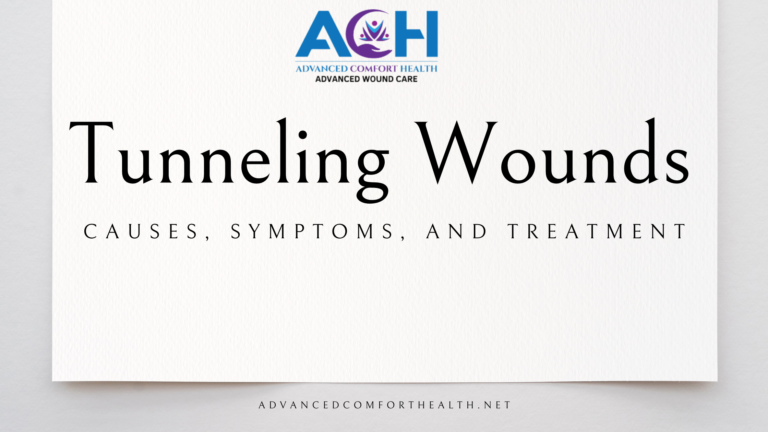One of the serious complications for patients with prolonged untreated wounds is tunneling wounds also known as sinus tracts. Such complications can result in improper wound closure thus posing a threat to fast tissue recovery.
What Is a Tunneling Wound?
Tunneling wounds are narrow, deep wounds with a small surface opening that extends into the subcutaneous tissue or muscle. These wound forms a tunnel, making assessment and treatment challenging, often requiring specialized interventions. Assessment of the wounds is crucial for effective patient care and promoting faster wound healing.
What Causes Tunneling in a Wound?
Tunneling in a wound can occur due to a lot of reasons. Understanding these underlying factors is crucial for effective management. Several factors contribute to developing tunneling wounds, including pressure, shear forces, and tissue ischemia.
Identifying and addressing these risk factors is essential in preventing and managing tunneling wounds.
-
Infection:
The most common case of tunnel formation is infection. Any infection that has resulted during the destruction and damage of the tissue will ultimately result in a tunneling wound. These infections can erode the underlying tissue and create a tunneling wound.
-
Pressure Ulcers:
Staying in a position for a long time can press the area of the skin associated. As a result of this prolonged pressure, the skin can’t get enough blood supply, and parts of it start to die, resulting in tunnel wound creation.
-
Trauma / Injury:
Sometimes, a bad trauma e.g.; any surgical wound, heat burns, or sharp cuts, can also result in tunneling the wound while being healed. It usually results when the injury is not treated properly.
-
Poor Circulation:
Reduced oxygen supply to the damaged area can increase the risk of tunneling wound formation at the site which can result in huge complications.
-
Moisture & Friction:
Moisture at the place of the wound can also affect the wound healing and tunneling wound formation occurs. Protecting injury resulting from friction can also reduce the risk of tunnel wound formation.
-
Dressing and Packing:
Packing tunneling wound must be done after the cleansing of the wound. This is a very crucial step in the healing process as it reduces the risk of formation of any abscess or pus formation at the wound site. Additionally, it protects the wound from getting too much pressure on it.
While dressing a wound, the size of the dressing should be kept in mind. Too short or too much dressing of the wound can result in a tunneling wound. Any dressing that can dehydrate the wound can also be a contributing factor in the formation of a tunneling wound.
Risk Factors of Tunneling Wound
Tunneling wounds present unique challenges in the healing process, including delayed closure, risk of infection, and potential for recurrence. Understanding these challenges is crucial for implementing targeted interventions.
-
Delayed Closure:
The presence of tunnels complicates the closure process of the wound, often leading to delayed healing. Traditional wound closure techniques may not effectively address the depth and complexity of tunneling wounds, necessitating specialized treatment approaches.
-
Risk of Infection:
Tunneling wounds create an ideal environment for bacterial proliferation and infection. The narrow channels provide sheltered spaces where bacteria can thrive, making these wounds more susceptible to infections. Infection delays healing and can exacerbate tissue damage and increase the risk of systemic complications.
-
Potential for recurrence:
Even after apparent closure, tunneling wounds may recur due to residual pockets of infection or inadequate healing of underlying tissue. Without comprehensive management addressing the underlying causes and structural integrity of the wound bed, recurrence remains a significant concern.
Understanding the diverse challenges associated with tunneling wounds is paramount for implementing targeted interventions that can optimize healing outcomes. By addressing such factors through comprehensive assessment, appropriate wound care strategies, and multidisciplinary collaboration, healthcare providers can effectively manage tunneling wounds and promote patient recovery.
How Tunneling Wound Can Be Treated?
Effective wound care techniques play a major role in healing mechanisms and preventing any further complications. While initiating the treatment of tunneling wounds, the first and most crucial step is cleansing the wound to avoid the microbial load that plays a role in tunnel formation and its maintenance.
To avoid any abscess development at the site, the wound should be packed properly. This packing also aids in the rapid healing of tunneling wounds. The packing of a tunneling wound should not be pressing the edges of the tunnel, to protect the healthy tissues from damage.
There are a few other techniques described below that can be put into practice while treating a tunneling wound.
-
Assessment Techniques
Accurate assessment of tunneling wounds is vital for devising appropriate treatment plans. There are various assessment techniques, including probing, imaging, and measurement methods, to ensure a comprehensive evaluation.
Effective management of tunneling wounds involves a multidisciplinary approach, encompassing debridement, dressing selection, and offloading techniques. Tailoring interventions to individual patient needs is paramount for successful healing.
-
Surgical Interventions for Tunneling Wound
In some cases, surgical interventions such as flap reconstruction or negative pressure wound therapy may be necessary for complex tunneling wounds. This slide will explore the indications and considerations for surgical management.
-
Patient Education
Empowering patients with knowledge about wound care, prevention, and self-management is integral in treating tunneling wounds. Educating patients on nutrition, activity modification, and wound monitoring promotes active participation in the healing process.
-
Collaborative Wound Care Approach
A collaborative care approach involving wound care specialists, nurses, and other healthcare professionals is essential for comprehensive tunneling wound management. This slide will emphasize the importance of interdisciplinary teamwork.
-
Outlook and Healing time for tunneling wounds:
When it comes to the treatment of tunneling wounds, understanding the outlook and healing time of tunneling wounds is essential for both the health care professionals and the patient.
Generally, such wounds require specialized care and proper time compared to superficial wounds. However, with sufficient wound care and effective treatment, tunneling wounds can heal successfully. It can be a time-consuming process but consistent wound care practices can help improve outcomes while minimizing complications.
Compared to other types of wounds, the healing time for the tunneling wound can be prolonged due to underlying tissue damage and complications. Some of the factors affecting the healing time of tunneling wounds are described as follows:
- Larger and deeper tunneling wounds
- Chronic health conditions
- Presence of infection
- Non-consistent follow-ups
- Psychological illness
- Age i.e. older adults experience slow wound healing compared to young people.
- Smoking Habits
- Poor nutritional status
- Administration of corticosteroids or immunosuppressants.
How Tunneling Wounds Can Be Prevented?
As it’s been discussed earlier, managing a tunneling wound can be a difficult task and may lead to complications if not addressed properly. By taking visionary steps to prevent tunneling wounds, you can maintain good skin health and the risks of developing such painful complications can also be reduced to a maximum extent.
Before delving deep into specific prevention strategies one should consider the underlying risk factors, the importance of early intervention & a healthy collaboration with healthcare professionals.
Following are some of the major steps that can be taken to prevent tunneling wounds from occurring:
- Regular body position changes
- Keeping skin clean & moisturized
- Maintaining a balanced diet
- Regular Physical activity
- Use of supportive equipment e.g: pressure-relieving cushions
- Regular skin checks
Conclusion
In conclusion, understanding tunneling wounds and implementing effective assessment and management strategies are crucial for promoting wound healing and improving patient outcomes. Continuous education and collaboration are key in addressing the challenges posed by these complex wounds. Understanding the multifaceted factors contributing to tunneling wounds is imperative for providing optimal care to affected patients. By addressing risk factors, embracing evidence-based practices, and fostering collaborative care, we can strive towards improved outcomes in tunneling wound management.
Frequently Asked Questions
Q: How can I tell if I have a tunneling wound?
Tunneling wounds may present with visible channels or sinus tracts extending from the main wound site. Other signs include foul odor, delayed healing, and increased pain or tenderness in the affected area.
Q: What are the early signs of skin breakdown that may lead to tunneling wounds?
Early signs of skin breakdown include redness, swelling, warmth, and changes in skin texture. These symptoms may indicate tissue damage and should prompt further assessment by a healthcare professional.
Q: Are there specific areas of the body more prone to developing tunneling wounds?
Areas of the body subjected to prolonged pressure, such as the sacrum, heels, and hips, are more prone to developing tunneling wounds.
Q: How often should I change positions to prevent tunneling wounds?
It is recommended to change positions at least every two hours to relieve pressure on vulnerable areas of the body and prevent tunneling wounds.
Q: What role does nutrition play in preventing tunneling wounds?
Proper nutrition, including a balanced diet rich in vitamins, minerals, and protein, is essential for maintaining skin health and supporting wound healing. Malnutrition can increase the risk of developing tunneling wounds.
Q: Is it necessary to moisturize the skin regularly to prevent tunneling wounds?
Yes, regular moisturization helps keep the skin hydrated and supple, reducing the risk of skin breakdown and tunneling wound formation.
Q: Is there any way to change position in immobile individuals to prevent tunneling wounds?
Caregivers can help prevent tunneling wounds by assisting with regular repositioning, ensuring proper nutrition and hydration, maintaining good skin hygiene, and promptly addressing any signs of skin breakdown.
Q: Are there any warning signs that indicate a tunneling wound may be developing despite preventive measures?
Warning signs of tunneling wound development include increased pain or tenderness, foul odor, drainage from the wound site, and visible channels or sinus tracts extending from the wound bed.

